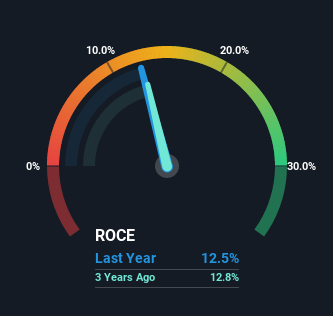- Sweden
- /
- Industrials
- /
- OM:HAKI B
Midway Holding (STO:MIDW B) Shareholders Will Want The ROCE Trajectory To Continue

If we want to find a stock that could multiply over the long term, what are the underlying trends we should look for? Typically, we'll want to notice a trend of growing return on capital employed (ROCE) and alongside that, an expanding base of capital employed. Ultimately, this demonstrates that it's a business that is reinvesting profits at increasing rates of return. Speaking of which, we noticed some great changes in Midway Holding's (STO:MIDW B) returns on capital, so let's have a look.
Understanding Return On Capital Employed (ROCE)
For those who don't know, ROCE is a measure of a company's yearly pre-tax profit (its return), relative to the capital employed in the business. To calculate this metric for Midway Holding, this is the formula:
Return on Capital Employed = Earnings Before Interest and Tax (EBIT) ÷ (Total Assets - Current Liabilities)
0.13 = kr98m ÷ (kr1.1b - kr317m) (Based on the trailing twelve months to June 2022).
Therefore, Midway Holding has an ROCE of 13%. That's a pretty standard return and it's in line with the industry average of 13%.
Check out our latest analysis for Midway Holding

In the above chart we have measured Midway Holding's prior ROCE against its prior performance, but the future is arguably more important. If you're interested, you can view the analysts predictions in our free report on analyst forecasts for the company.
The Trend Of ROCE
The trends we've noticed at Midway Holding are quite reassuring. Over the last five years, returns on capital employed have risen substantially to 13%. The company is effectively making more money per dollar of capital used, and it's worth noting that the amount of capital has increased too, by 28%. So we're very much inspired by what we're seeing at Midway Holding thanks to its ability to profitably reinvest capital.
In another part of our analysis, we noticed that the company's ratio of current liabilities to total assets decreased to 29%, which broadly means the business is relying less on its suppliers or short-term creditors to fund its operations. Therefore we can rest assured that the growth in ROCE is a result of the business' fundamental improvements, rather than a cooking class featuring this company's books.
In Conclusion...
To sum it up, Midway Holding has proven it can reinvest in the business and generate higher returns on that capital employed, which is terrific. Considering the stock has delivered 34% to its stockholders over the last five years, it may be fair to think that investors aren't fully aware of the promising trends yet. So with that in mind, we think the stock deserves further research.
On a final note, we've found 2 warning signs for Midway Holding that we think you should be aware of.
While Midway Holding may not currently earn the highest returns, we've compiled a list of companies that currently earn more than 25% return on equity. Check out this free list here.
If you're looking to trade HAKI Safety, open an account with the lowest-cost platform trusted by professionals, Interactive Brokers.
With clients in over 200 countries and territories, and access to 160 markets, IBKR lets you trade stocks, options, futures, forex, bonds and funds from a single integrated account.
Enjoy no hidden fees, no account minimums, and FX conversion rates as low as 0.03%, far better than what most brokers offer.
Sponsored ContentValuation is complex, but we're here to simplify it.
Discover if HAKI Safety might be undervalued or overvalued with our detailed analysis, featuring fair value estimates, potential risks, dividends, insider trades, and its financial condition.
Access Free AnalysisHave feedback on this article? Concerned about the content? Get in touch with us directly. Alternatively, email editorial-team (at) simplywallst.com.
This article by Simply Wall St is general in nature. We provide commentary based on historical data and analyst forecasts only using an unbiased methodology and our articles are not intended to be financial advice. It does not constitute a recommendation to buy or sell any stock, and does not take account of your objectives, or your financial situation. We aim to bring you long-term focused analysis driven by fundamental data. Note that our analysis may not factor in the latest price-sensitive company announcements or qualitative material. Simply Wall St has no position in any stocks mentioned.
About OM:HAKI B
HAKI Safety
Provides safety products and solutions for infrastructure, energy, industry, aviation, rail and construction, and civil engineering industries in Europe and North America.
Good value with reasonable growth potential.
Market Insights
Community Narratives



